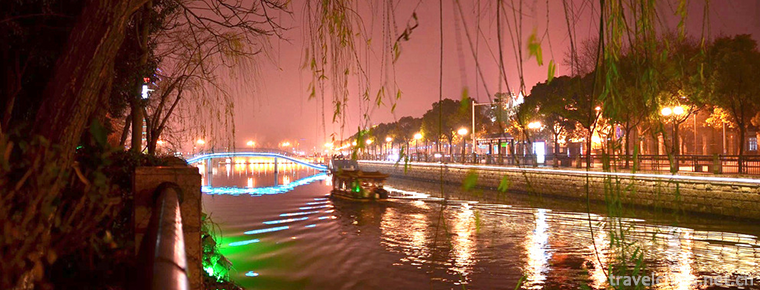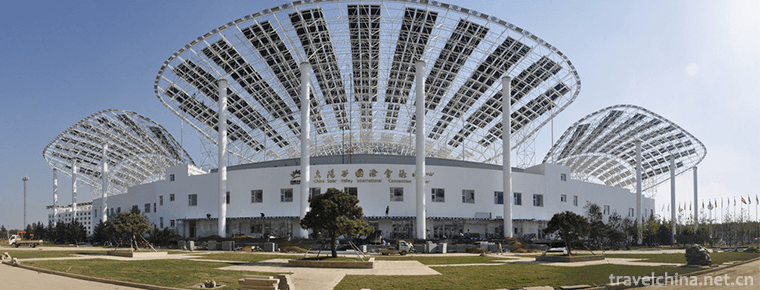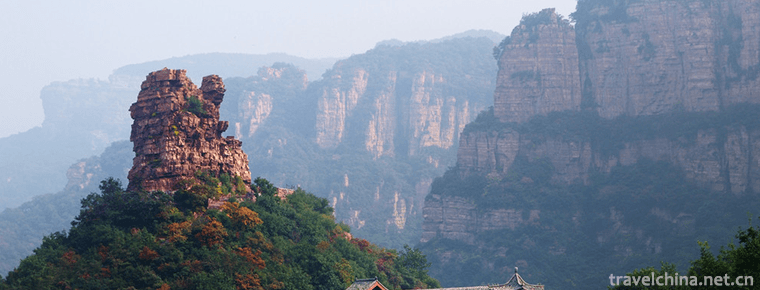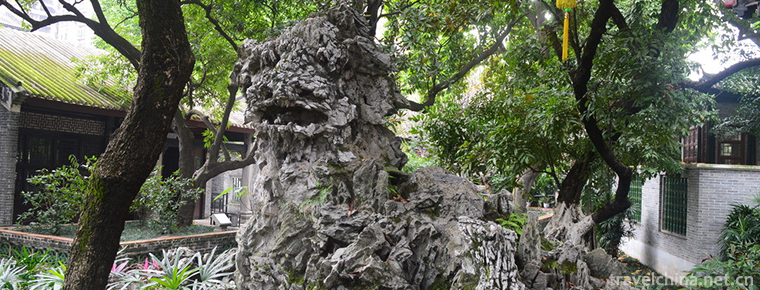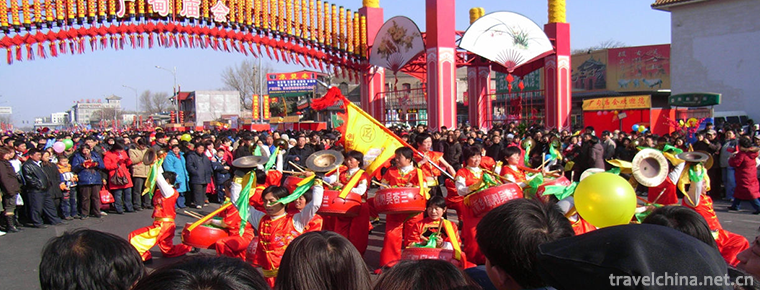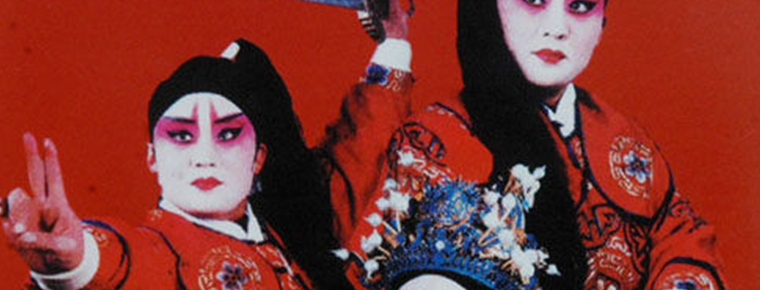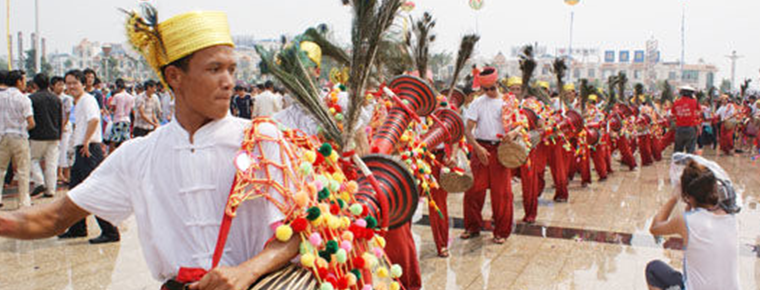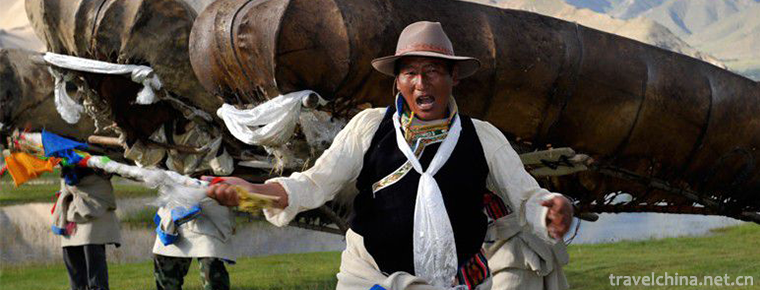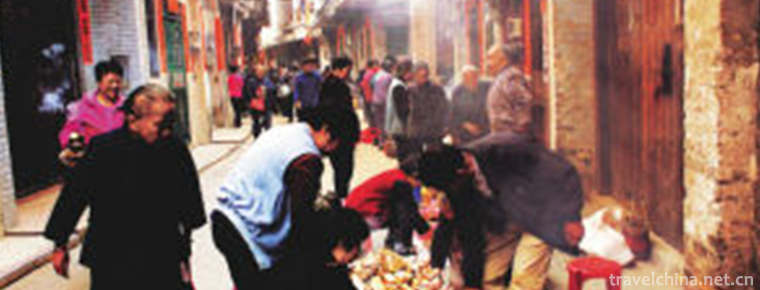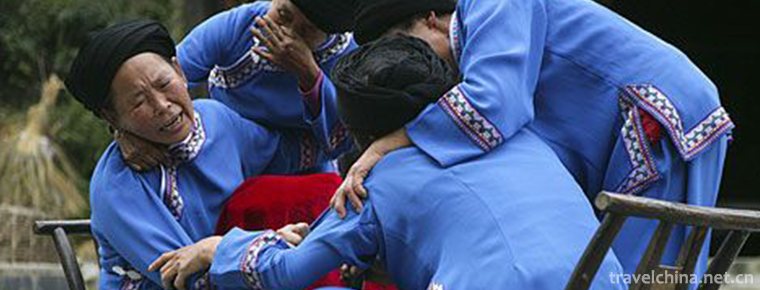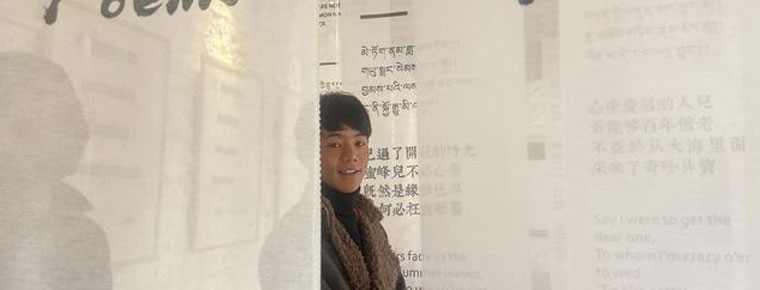Shangrao Lingshan Scenic Area
Shangraolingshan Scenic Area, located in the north of Shangrao County, Shangrao City, Jiangxi Province, is a national scenic spot with an area of 160 square kilometers. Lingshan is listed as the "Thirty-third Fortune Land under Heaven" in Taoist books.
Because the mountains are rolling like a beautiful woman lying asleep in the south of the Yangtze River, she is praised as "Sleeping Beauty" by the world. According to Shangrao County Chronicle of Tongzhi 11 years in Qing Dynasty, there are 72 peaks in Lingshan, the main peak is 1496 meters above sea level. There are also some valuable animals and plants in the mountains, such as pheasant, flounder, stone ear, and underground resources such as tantalum, niobium, barite, zinc and iron. Celebrities such as Wang Anshi, Xin Qiji and Han Yuanji praised Lingshan. Feng Xuefeng, a modern writer, wrote Lingshan Song in 1941 to express his ambition.
In October 2006, Lingshan was approved as a provincial scenic spot with a planned total area of 101.5 square kilometers. In December 2009, the national scenic spots were declared successful, and in December 2015, they were rated as national 4A-level scenic spots. Lingshan is located in the central tourist area of Shangrao City. It has unique natural environment, complex geological structure and diverse landforms. It is a holy place of Taoism and Buddhism. Taoism is the 33rd blessed place in the world. It is a mountain scenic spot integrating vacation and leisure, sightseeing experience and religious pilgrimage.
geographical position
Shangrao Lingshan Scenic Spot lies in the north of Shangrao County, spanning the towns of Mingyang, Hucun, Qingshui, Wangcun, Shiren, Wangxian, Zhengfang and Huatan Mountain. It is bordered by Geyuan Town, Hengfeng County in the West and Rao Town, Dexing City in the north. Gaonanfeng Village is located in the most core area of Lingshan, 25 kilometers from Shangrao County City and Shangrao City. It is situated in the central tourist area of Shangrao City, 85 kilometers from Sanqing Mountain and Gufeng City. Ninety kilometers, 155 kilometers of Longhu Mountain and 121 kilometers of Wuyi Mountain are located in the middle of the four national scenic spots of Sanqing Mountain, Guifeng Mountain, Longhu Mountain and Wuyi Mountain. They are the intersection points of radiation from the four mountains. The Zhejiang-Jiangxi electrified railway, Shanghai-Kunming Expressway and 320 National Highway are accessible.
Topography and climate
The Lingshan Mountain belongs to the middle-low mountain landform area with erosion structure. Its main vein is 1000-1400 meters above sea level and its topography is steep. Affected by oceanic climate, the climate is mild. The annual accumulated temperature ranges from 3600 to 4800 C, and the average temperature is about 15 C. Rainfall is abundant, annual rainfall exceeds 2000 mm, surface water and groundwater resources are abundant, forming eight streams such as Castanopsis, Mingyang River, Shiren River, Wangxian River and hundreds of famous springs such as Longquan, Pearl Spring and Tianquan. The average sunshine time is 1939.5 hours, and the total annual solar radiation is 110647.6 calories per square centimeter.
natural resources
Biological resources
Shangraolingshan Scenic Spot is a subtropical monsoon humid climate, which provides good natural conditions for the growth of animals and plants. According to the investigation of forestry department, there are 204 species of arboreal plants in 72 families, 12 species of bamboo and 221 species of Chinese herbal medicine in the scenic area. Ancient and famous trees are all over the scenic area. Agricultural and forestry products such as Gongcha, tea oil, kiwifruit, stone ear, garlic, earth paper, etc. There are more than 20 species of birds, 20 species of mammals, 9 species of amphibians, 30 species of snakes and insects, goats, clouded leopards, stone chickens, yellow muntjac, salamander, cucumber fish, hawk turtle and other rare animals. Note: Source of Atlas Data
mineral resources
About 800 million years ago, in the early Sinian period, Lingshan area began to subside, forming important multi-layered ore-bearing formations. Minerals include granite, fluorite, crystal, tungsten, tin, copper, lead, zinc, niobium, tantalum, vanadium, rare earth, phosphorus, barite, stone coal, etc. Granite, niobium, tantalum, vanadium and other reserves are the largest, of which granite reserves are about 500 million cubic meters. Sesame white, Shangrao red and Wangxian green not only have beautiful texture and color, but also have the characteristics of compression resistance, wear resistance and acid resistance. The developed stone materials are sold in Shanghai and Hangzhou. Crystal is the most precious and has a long history of development. There is a record of Shangrao Crystal in the Han Dynasty's Shenlong Herbal Classic. The destruction of mountain forests in the Northern Song Dynasty due to excessive exploitation attracted the attention of Wang Anshi, the first assistant of the dynasty, and criticized this phenomenon in his poems. Lingshan Crystal has three kinds: white, brown and dark green. Especially, tea and dark green are the treasures.
Natural landscape
Montmorency Falls
Crystal Waterfall is located in the southeast corner of the scenic area of Crystal Mountain. It is named Crystal Waterfall because it is located under the Crystal Peak and reflects the sun in a flash. Crystal waterfall in Shiping, under the peaks of Crystal, the Longchi water of Jishiping Peak, the tidal water of Crystal Peak and other mountain springs gather in the first pool of "Three Pools Reflecting the Moon", and then overflow from the mouth of the pool to form a waterfall. Crystal waterfall falls 244 meters wide and 50 meters wide.
The magnificence and beauty of the crystal waterfall make many famous scholars come to visit and write many poems and essays about the waterfall. Fang Yang, a poet of the Qing Dynasty, wrote a poem entitled "Crystal Mountain Waterfall Spring": "A flying spring can be seen in the depths of the Wanshan Mountains, and the river flows down for nine days. The rocks are shattered and the pearls are worn to pieces. Rainstorms are sunny, moss is moist, ice-skating, cold and green. Browns are full of joy and pleasure, and the crystal curtain sits outside the fairy.
Hua Feng Feng
Huabiao Peak is located in the west of Zhengfeng, 1345 meters above sea level. It is round, generally thick up and down, as high as more than 100 meters. Its walls are smooth and smooth, and people can't climb it. Its top can be seen only when looking up to the hat. The stripes of the peak body are vertical and horizontal, and there are ancient pine in the stone crevices between the peaks. Mountains overlap around Huabiao Peak, while Huabiao Peak stands out among chickens. There are Shicheng lane to climb Huabianfeng, Qingshui Township in the south, Shicheng ancient temple, through Ma Shibao, inclined to interlayer Lingshan Valley mouth, the Lane South steep and North gentle, dangerous Ma Shibao, empty wings, climbers easy to climb up and down, known as "Jingyin and Yang separated sheet of paper". Along the way, there are echo wall, Tiannu Sanhua, a line of sky, Bagua Stone and Owl Stone.
Nanfeng pond
Nanfengtang is located 5 kilometers south of Shirendian. It is a platform with an elevation of more than 800 meters and an area of less than 1 square kilometer. Therefore, the platform is like a pelvis, gathering Baigu, Yanqian Zhufeng mountain springs into ponds, water clear bottom, sparkling, reflecting the peaks, so it is named Nanfeng Tang.
Nanfengtang is surrounded by cliff-like walls. Only two ancient paths, excavated by the ancients, can be climbed up from the rock bottom. Along the way, we can appreciate the strange rocks such as frogs, raccoons, flying tortoises and so on. From the God frog stone to the top, the two peaks of Yanqian and Baigu were locked by a male, and the gate was narrow enough for only one person to pass through. Therefore, the ancestors built the gate and named Tianxian after it, and wrote the word "Tianxian" by the calligrapher in Yinei. Entering Tian Dangerous Pass means entering the hinterland of Nanfengtang. Nanfeng Tangbian Guankou Temple is a primitive building. Note: Source of Atlas Data
Mezzanine Lingshan
From the single peak of Lingshan vein to Zhenfeng, it moves westward in two veins, forming an alpine platform more than 2000 meters long and 500 meters wide at an altitude of more than 1000 meters. It is historically known as Dongtai. The local people call it "Interlayer Lingshan" or "Mountain Outside Lingshan". Lingshan Mountain, with rugged mountain paths and steep cliffs, is surrounded by hundreds of green bees. There are cat turning steamer peak, Tiannu scattered flower peak, Huabiao peak, Owl peak and so on. Thousands of marvellous stones lie, lean out, stand up and hang upside down on the platform. Lingshan interlayer, there are springs at the peak and springs at the bottom of the weird rocks. Tian Po Spring has high medicinal value. Drinking can stimulate body fluid and quench thirst, prevent heat and reduce fire, stop diarrhea and remove phlegm. External use (washing) can relieve inflammation and remove blood stasis, promote blood circulation and promote muscle growth. Sandwich Lingshan is also a place where birds and animals live and multiply. Hundreds of birds leave their nests and return to their nests. Goats jump on the cliff and monkeys play in the forest. Note: Source of Atlas Data
Taiji rock
Taiji Rock is located in Pingxi Canyon, south of Dongtai Peak, with an elevation of 861 meters. There are grotesque rocks, dense jungles, and caves within a square kilometer of Taiji Rock. Taiji Rock is a huge rock in the cliff that extends southeast. The cave is 5 meters high and covers an area of about 40 square meters. The cave mouth is short and narrow. It needs to bow to enter. Rock spacious, round as a giant ball, rock wall seams and protrusions, like the Pisces map of Taiji, hence the name. There are holes in the Taiji Cave, which are connected with each other and arranged in the direction of the Eight Diagrams. It is easy to lose its direction when searching for rocks.
At the end of the Eastern Han Dynasty, the Daoists in Taiji Rock were renowned as real people, and successive generations of Daoists came. The broken walls and incense stoves of Taiji Palace and the plaque of Taiji Rock Zen Hall still exist. Near Taiji Rock, there are Narcissus Rock and Qiankun Rock. It is said that Taoists once acquired Taoism and became immortals.
Ming Yang Lake
Mingyanghu is located in Mingyangxiang, 50 kilometers away from the county seat. It was formerly called Mingyangguan Reservoir and later renamed Mingyanghu. Built in 1959, it is an alpine Pinghu with an area of nearly 3,000 Mu and a water storage capacity of 42.4 million cubic meters. From the reservoir dam to the right to Dongling Village, there are steep mountain paths to climb crows, dragon heads, dragon whiskers, square stones and round piers.
Dongling Waterfalls Group
Lingshan Peak has many high cliffs and passes. Most of them have waterfalls falling down. The majority of them are in Mingyang Township. Triassic waterfalls, Huilong waterfalls, Yudao waterfalls without Pandun, Gaoyu waterfalls and Silver Ball waterfalls in Xilonggang are famous waterfalls in Lingshan Mountain. Because they are located in the eastern part of Lingshan Mountain, they are collectively called Dongling waterfalls.
The Triassic Waterfall is located on the western side of the Mingyang Reservoir. In spring and summer, the mountain torrents broke out, and the floods flowed down the cliffs. Because of the mountain situation, the waterfalls became Triassic. The total length of the waterfalls was about 300 meters. The waterfalls were directly injected into the Mingyang Reservoir.
Huilong Waterfall is located in Tantou Village of Mingyang Township, which is formed by the fall of streams. From Tantouxi to Tantou Village, it falls down the cliff and forms the first cascade of waterfalls. The waterfall that rushes into the deep pool is blocked by boulders. It raises a huge wave that surges up to the height of the lake, rolls back, and then rushes down from the boulders to form a second cascade. Because a cascade of waterfalls is blocked by rocks, it is called Huilong Waterfall.
The Yuste Waterfall without Pandun is located in Jiangshan Village, Mingyang Township, without Pandun. The stream gurgles down to the pier-less side and flies downhill from side to side. It is 120 meters high and 30 meters wide. The water flows through the three-stage terrace cliff and falls again and again, forming a triple waterfall. Looking from afar, the waterfall in the sunshine is like three steps to climb the Tianyu step, so it is called the Yujie step waterfall.
Gaoyong Serial Waterfall, located in Gaoyong Creek of Mingyang Township, falls suddenly to Baizhang cliff in front of Xiadongcun Shuikou, forming a waterfall. Woods and bamboo forests on both sides sway with the wind, sometimes covering part of the waterfall, sometimes making the waterfall all show, like a huge white silk flying across the sky with the wind, so it is called Gaoyu silk waterfall.
Xilonggang Silver Ball Waterfall, located in the west of Mingyang Township, flows to Huangjing Bend, along a path of tens of meters and half round boulders, looks like a white ball inlaid in the evergreen bushes, crystal like jade, white like silver, so it is called Silver Ball Waterfall.
Round pier peak
Yuandun Peak is located in the beautiful nose of the sleeping beauty in Lingshan, at an altitude of 1324 meters. The peak is round and pier-like, so it is called Yuandun Peak. The north-south suspended rock of Yuandun Peak is vast, and the ancient pine is transversely long in the stone crevices with different shapes. On the side of the peak, there are springs one or two days before the rain. Yuandun Peak, because of its unique and dangerous combination of peaks and rocks, is a place for travelers of Buddhism and Taoism in past dynasties. In Ming Dynasty, three immortal palaces were built on the top, and the walls were chiseled and covered with iron tiles for the statues of the three immortals. There is a ramp between the peak and the waist. Local residents often climb the peak to worship, legend has it that some unworthy Taoists, indecent into young women, official buildings immediately collapsed, three immortals that turned into three giant birds flew away, today there are still remnants of the wall, "Qianlong sixty years" stone carvings can be distinguished. On the stone wall in the north of the peak, there are figures, flowers and birds, rock paintings. There is a huge arrow pointing to the bay. Legend has it that the treasure map left by the Yellow Nest is a treasure map. There are ancient roads under the peak, which are wide enough to ride along.
Sky ladder peak
Tian Ti Peak is located in the south of Lao Ya Peak, 1496 meters above sea level. It is the highest peak of Lingshan Mountain. Its ridge has natural stone steps such as Tian Ti, hence its name. Zhou Shaodou, a Ming Gongsheng, wrote the poem "picking up clothes and walking up the ladder" when he was swimming at this peak. There are tens of thousands of weird rocks on the peak.
Although Tian Ti Feng has natural stone ladder, but the danger is difficult to climb apes. Legend has it that Meng Liang, a famous general in the Northern Song Dynasty, chiseled stone at the danger and carved stone to record, the inscription is weathered and unrecognizable. It is also said that in ancient times, there was a woodcutter who climbed up the top of the peak through a ladder and built two immortals to play chess in the clouds, then stacked three stones to watch chess. At dusk, the immortal said, "When you watch chess here, you can see the changes in your family? We will go to Penglai to attend the meeting, and we will return soon." With a wave of his sleeve robe, he sent the woodcutter down the hill. When the woodcutter returned to the village, his house had already collapsed and his parents had died. He touched the wood knife on his waist and it was rusty. Woodcutter and his fellow villagers talked about their experiences. The villagers respected him as Taizu Gong. It was really "seven days in the mountains, thousands of years in the world." It is said that the stack stone of Woodcutter's chess watching still exists.
Fan Xian altar
Fairy Temple is located in the west of Shiyongting Pavilion. It is a high mountain terrace with thousands of square meters. It is said that Fairy Gu was lost and stayed here at night, so it is called Fairy Temple. The temple is surrounded by serrated peaks, including strange peaks, strange rocks, Longquan, ancient temples and many other attractions.
There is a cave in the middle of the Temple of Mixian, which is composed of two palm-shaped boulders. The cave is more than 20 square meters high. The cave is called Guanyin Hezhao Stone and the cave is called Mixian Rock. There are natural stone shrines in the caves to worship supernatural statues, and mountain people often come here to worship them. There is a small hole in the rock wall beside the niche. It is said that in ancient times, several meters per day were used for food by monks in Jiulong Temple.
Shuanglong pine
Shuanglongsong is located on the outside of Jingjingling Mountain in Jingjingshan scenic spot. Therefore, the pine is divided into two trunks above 2 meters from the ground. It emerges from the sky and slopes up into the clouds. It looks like two water dragons, so it is called Shuanglongsong. The tree age of Shuanglong Pine has reached more than 800 years. It is 25 meters high, crown 60 square meters and breast diameter 120 centimeters. In the morning, standing beside the tree, you can see the rising red sun on the eastern horizon, just between the trunks, just like a picture of Erlong Drama Pearl.
On the side of Jingjingling Ancient Road is the longest, highest and deepest traces of the Lingshan Granite Class Ancient Road. The whole course of the ancient road is 30 miles and the highest point is 948 meters above sea level. In the fifteenth year of Jiajing in Ming Dynasty (1536), Hu Shilian of Shenlu Village, Gaonanfeng, invested in the excavation of the water-Rishi ladder. In 1565 A.D. (Jiajing 44 years), Nantang Old Road invited the county to govern the Sun when it raised funds at the top of the ridge for the pavilion, known as the "Yongshi Pavilion", also known as the Crystal Cave. The next year, residents of Qingshui Wudu and Gaonanfeng 16du will make huge donations to pave all sections of the road. Wanli Six Years (1578), Wang Shengsi, Zhu Boying, Wang Shiduan and others donated money to dig wide crystal ladders and lay stone levels. Stone carvings still exist on the stone wall during the six years of Ming Wanli. The ancient road of Crystal Ridge connects Lingshan north and south. Food, mountain goods, earthen paper and other items come and go in and out by this way. Therefore, the countrymen come and go in endlessly, and there is a sound of "beating the pestle" to assist them. Since 1992, Panshan Highway has been constructed at both ends of the old road, and the footstone grade road has been shortened to 15 miles.
Places of historic figures and cultural heritage
Dongshan rock paintings
Dongshan Rock is depicted on the wall of the cave behind Dongshan Mountain in Mingyang. The lines are crisscrossed and there are mountains and roads, similar to the topographic map, with an arrow pointing to the bay. According to legend, this picture is a treasure map of Huangchao.
In 878 A.D. (Five Years of Emperor Qianfu of Tang Dynasty), the Huangchao Uprising Army fought with its officers and soldiers, and pursued all the way to Mingyangguan, which was called Zhaimen Cave in ancient times. When the iron gate was closed and could not be attacked, they encroached on Mingyang by two routes. All the way, crow lane, all the way to the western peak, before entering the Mingyang. The Yellow Chao Rebellion Army and its officers and soldiers fought fiercely in Huangmao, causing heavy casualties on both sides. The blood flowed into rivers in Mingyangguan and the corpses were scattered everywhere. The local people buried the corpses killed by the rebels in situ and then fled to other places. For quite some time, Mingyangguan became an absolutely uninhabited place. In the Mingyang area, there has been a folk song of the Yellow Chao Army attacking Mingyang: "If you can't break the firewood door, you can get crows at once; if you can't break the Mingyang Pass, you can shoot the west mountain immediately." According to legend, Dongshan rock paintings were carved with swords when Huangchao generals retreated, and the images implied hidden treasures and mysteries.
Taoist immortal peak
Taoist Xianfeng, formerly known as Yongbi Mountain, is located behind the village of Confucianism in Wangxian Township. It is 910 meters above sea level. The Emperor of the Northern Song Dynasty sealed it as Taoist Xianfeng. In the first year of the Eastern Han Dynasty, Hu Chao went down with his uncle Hu Zhaonan to Yizhilingshan, Hu Zhaoyin was in Bugufeng Yangzhenyan, Hu Chao was in Yingbifeng. Hu Chao studied Taoism, built furnace and refined potions, and was a famous Taoist real man. Hu Chao Chang traveled all over the country, preached Taoism and applied medicine. After his immortality, he was named "Hu Gongzhen" by Emperor Wudi of Jin Dynasty.
In the second year of Xuanhe in the Northern Song Dynasty (1120), the prince was ill. He called a good doctor from all over the world. Suddenly, a scholar went to Jinge and asked the sage why. The Taoist monk said, "Poor Tao lives in front of Wuyang Mountain, the west of Lingbei Daji in Xinzhou, right of the Yangtze River." Play a bang, leave a dan, empty away. When the prince took Dan, he suddenly recovered from his illness. Emperor Qixing said, "If it is really a fairy doctor!" Shengshang sent envoys to FengHu Chao as "Xuantan Ziji Cave Real Heavenly Teacher Hu Zhenren" and Bishan as "Tao Real Immortal Taoist Immortal Peak". The Taoist monk Xianfeng got its name from this. Huchao Alchemy Site still exists today.
Shi Yong Ting
Shiyong Pavilion is located at the top of the crystal peak. It took more than 3,000 workers to build this pavilion and was named Shiyong Pavilion after it was completed. Therefore, the pavilion looks like a cave through a mountain. Therefore, the local people call it "Crystal Cave".
In the forty-fourth year of Jiajing in Ming Dynasty (1565), Nantang Laodao Sicheng reported to the county government that a pavilion should be built at the top of Jingling Ancient Road to help passers-by rest when crossing Lingshan Mountain. With the consent of the county's grandson, the pavilion should be built by collecting funds among the people, chiseling stones, and inspecting the inspector of Ming Dynasty, Shi Guirong, writing Wenle Stone in the pavilion wall.
Shiyongting Pavilion is made of granite strips and rocks, and its top is arched. The top and sides are covered with mud. It is 4.6 meters long, 3.4 meters wide and 3.3 meters high. There are two stone benches on both sides. Looking like a cave through a mountain, it passes through a cave on the famous Crystal Ridge Ancient Road. The villagers'mountain goods trade on the north and south slopes often takes a rest in groups in the pavilion.
Shiyongting Pavilion was built after repeated wars, bullet marks and knife marks, still solid and intact. The Pavilion is warm in winter, cool in summer and fresh in air. It is an extremely important scenic spot of Lingshan Crystal Mountain.
A Street in Ming and Qing Dynasties
A street in the Ming and Qing Dynasties is situated at the foot of the Shiren Peak, next to the Shiren Temple, 38 kilometers away from the county seat, formerly known as Lujiadun. In the first year of Taikang in the Western Jin Dynasty (280), Fengzhao built a stone ancestral temple. The name will be changed later. After the imperial seal of Emperor Huizong in the Northern Song Dynasty, Shirendian was well-known. It came from Fujian, Zhejiang, Anhui and Jiangxi provinces, where pilgrims were like clouds. Cigarettes were flourishing, commerce was flourishing and shops were springing up. The Ming Dynasty formed a "bow" shaped street. The street is divided into five sections, namely Xidi Street - Xia Street - Zhongjie - Miaomen - Majiadian, with a total length of 1.5 miles. There are "four lanes", "three bridges", "two halls", "two pavilions", "one pavilion" and other ancient buildings. The streets are full of stones and cobblestones. The shops are made of stone and wood, and most of them are horse-drawn buildings. There are Zhou's mansion, Dong's mansion, Jiang's mansion and Yu's mansion, which were built in the Ming Dynasty. They have more than 600 years of ancient camphor at the bottom of the stream and 500 years of ancient trees such as Zhongjie Ginkgo biloba. Stone Man Hall, Wenchang Pavilion, Wan'an Bridge and other ancient buildings with a long history in Ming and Qing Dynasties are well preserved. The shops are still well preserved. They are known as "100 stores in Li Street" and are called "One Street in Ming and Qing Dynasties" by cultural relics workers.
Fang Dian
Fangdian, a local name wooden spoon shed, is located under the high stone wall of Lingshan Mountain, Qingshui Township, where a spoon stalk extends out, surrounded by mountains, stands out as a chicken herd and a meteorological Xuanlang. In 1834, Wang Chunrong of Shuangxi lived here with his husband. He picked tea, flowers and Cymbidium to cure illness and save people. He refused to refuse to come to Shiqingming and light meals. He set up a Taoist hall, ate Changzhai, accumulated baht and did good deeds extensively. In 1986, he died of immortality. In 1988, villagers built temples and sacrificed his body. Quartet believers called it "Lingshan Mother". In March 2002, Professor Wang Zheng of the Chinese Academy of Sciences praised Lingshan Mother as the incarnation of Lingshan Sleeping Beauty.
Fangdian Temple is divided into three halls, with a wooden structure of bundles, with a construction area of 500 square meters. Main Hall Gexian Hall, Wangge Xiangong Statue, East Hall Earth Mother Hall, for the image of the Earth Mother. The Goddess of Mercy Hall in the West Hall sits on the top of the shrine like the mother of Lingshan. Lintel couplets, both rigid and soft fonts, exotic and smooth. On the side of the hall are the newly built Zhaitang, Zen rooms and dozens of guest rooms. On Lingshan Mother's Birthday, thousands of pilgrims come from Fujian, Zhejiang, Jiangxi and Anhui provinces. Especially in the Xin'anjiang area of Zhejiang Province, more than 100 people take a special bus to worship, twice a year, every year. Fangdian Temple is adjacent to the ancient temple of Shicheng, and the path of secluded forest and Buddhism and Taoism are interdependent. On weekdays, bells and drums whistle, red gas fumigation, firecrackers continue to ring in the ears.
Ancient Battlefield Sites
The ancient battlefield site of Crow Lane is located in the valley between the two peaks of Crow and Zhongtai. It is wide in the South and narrow in the north, and is over 100 meters long. The local people call it Crow Lane. Crow Lang peak rock cliff, narrow lane mouth, forming a pass, narrow north and south, stone cliff cliff, ancient road digged by the ancients winding, complex terrain, extremely steep. The parks are full of strange stones and caves. There have been many wars in the history of this area. The legend of the Yellow Nest crossing the Crow Lane with horses has been passed down all the time. The ruins of the fortress at the height of the Pass remain.
In October 1933, Fang Zhimin's Red Army temporary headquarters set up this area and built forts at both ends of the langkou. In the autumn of 1934, the main force of the Red Army went north to resist Japan. In order to protect the safe transfer of the headquarters, the Red Army blocked the enemy with a company's force in the crow. The battle was extremely cruel, and all of them were killed after the grain was destroyed. Crows can see piles of shrapnel cartridges and bury the loyalty of martyrs. Make a clear spring, never dry up for many years, more than a hundred people can't drink it. Passage roads, hidden in the jungle cliff on the north and South slopes, are steep and easy to defend and attack.
Top Tourist Route
Article 1: Zuoxi - Pingxi - climbing the highest peak of Lingshan - Pingxi - Zuoxi
Article 2: Shicheng - Huabiaofeng - Interlayer Lingshan - Jinjitan - Fangdian Temple






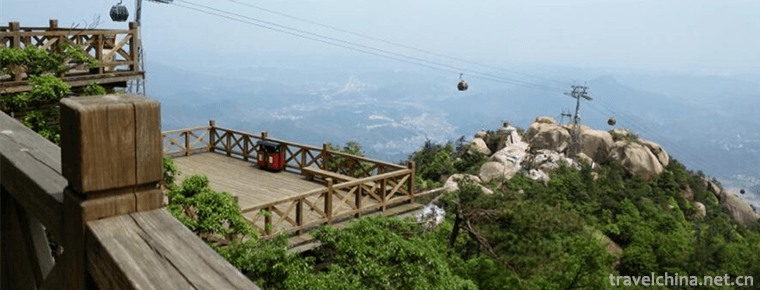
-
Hao River
Haohe River surrounds the old city of Nantong, like a gourd, like a Pearl chain, known as the "emerald necklace" of Nantong City. It is a national 5A tourist attraction..
Views: 190 Time 2018-12-06 -
Chinese Sun Valley
Located in the development zone of Dezhou, Sun Valley of China is the largest base of research, development, testing, production, education and tourism of renewable energy in the world..
Views: 124 Time 2019-01-18 -
Checkerboard Mesa Qipanshan Mountain
Qipanshan is located in the northeast of Shenyang City, adjacent to Fushun in the east, Hunhe in the west, Tieling in the South and Hadaling in the north. It is located .
Views: 226 Time 2019-02-07 -
Qinghui Garden
Qinghui Garden is an ancient garden building built in Ming Dynasty. Located in Qinghui Road, Daliang Town, Shunde District, Foshan City, Guangdong Province,.
Views: 204 Time 2019-02-07 -
Changdian Temple
Changdian Temple Fair is a traditional folk custom and folk religious belief activity in Beijing. Among the many temple fairs in the old capital city, only the temple fairs in Changdian.
Views: 172 Time 2019-04-16 -
Big flat tone
Da Ping Diao (also known as Ping Diao, Da You Bang and Da Bang Opera), one of the local traditional operas in Henan and Shandong Province, is one of the national intangible cultural heritage..
Views: 216 Time 2019-04-23 -
Dai Elephant Foot Inspiration
There is also a legendary story about the origin of the Dai elephant drum. Legend has it that Mengzhai area in ancient times was a beautiful lake rippling with blue waves. But there are pythons and to.
Views: 168 Time 2019-04-24 -
Kuozi Guzi
Guzi, also known as "Guzi Dance" and "Cowskin Boat Dance", is a unique folk dance of two groups of Junba in Chabalang Village, Qushui County, Tibet Autonomous Region. In 2008.
Views: 125 Time 2019-05-10 -
Liaobu fragrant Market
Liaobuxiang City is a traditional folk activity. During the Wanli period of Ming Dynasty, the scent of Guanxiang perfumed over Liaobu Town in Dongguan every day. Numerous guanxiangs were transported f.
Views: 173 Time 2019-05-13 -
Tujia Wedding Song
The Tujia people living in the border areas of Hunan, Hubei, Chongqing and Guizhou are an ancient civilized nation with a long history and traditional customs, and retain strong national characteristi.
Views: 206 Time 2019-06-23 -
Yao an Bazi Cavity
On June 7, 2008, Yao'an Baziqiang, declared by Yao'an County, Yunnan Province, was listed in the second batch of national intangible cultural heritage list with the approval of the State Council. Heri.
Views: 312 Time 2019-07-11 -
The announcer Ding Zhen will not be on duty until half a year later
On December 6, just after yesterday's live media broadcast, Ding Zhen met with more than 20 fans from all over the country to take photos at noon. Ding Zhen is no longer as shy and helpless as he was when he first met a stranger. After half a month's popularity,.
Views: 114 Time 2020-12-06
